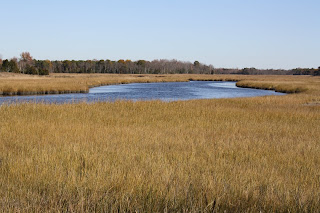Last Autumn, I traveled to Dividing Creek at the invitation of two decoy carvers I'd met while doing fieldwork in Paulsboro and beyond. It was an opportunity to see more of their decoys, in the living context of the duck hunt. That day, I'd also be able see their hunting cabin, and learn more about their work.
I stowed my camera in the car and headed southeast from Philadelphia, really excited about the trip. I love going out to the meadows. There are moments when, as you look out across a sea of meadow grass, and take in the sweeping channels and the ponds, you can imagine you’re in a timeless place.
When I arrived at the hunting shack that morning, I had time to take some photos before the others arrived. Here’s my first shot of the creek:
 |
| Dividing Creek Looking East from Rt. 553 |
I continued taking photos all around the site until Sean Sutton and Jode Hillman arrived. We talked about decoys and duck hunting as they tended to their gear. After a while, some other hunters arrived. They unlocked the hunting shack door, to get some food and drink, and show me around. Here's a photo of a portion of the shack's interior. It's a cultural artifact in its own right!
 |
| Hunting Shack Kitchen |
Someone got a fire going in the charcoal grill along one side of the shack, and after a while there were a dozen hamburgers cooking and rolls toasting. Somebody else cracked open a beer. But we all stayed on the subject of decoys.
There’s a classic text called Wildfowl Decoys, and it's kind of the bible of duck decoys. It was written by Joel Barber, an early collector, whose extraordinary collection is now on view at the Shelburne Museum in Vermont. You can access the museum's decoy page here. Anyway, the guys got to talking about a certain decoy, someone produced a hardcover copy of Barber, and everyone gathered around to look and discuss. These photos capture something of the flavor of that discussion:
 |
| Consulting the Source |
There are two major decoy carving regions in New Jersey, each with their own sub-regions and individual styles. These New Jersey regions are the coastal region, stretching, roughly, from the Atlantic Highlands to Cape May; and the Delaware River carving region, stretching, roughly, from the mouth of the Delaware River at Delaware Bay, northward to Trenton. At Perkins, our interest lies squarely with the Delaware River decoys -- for the most part.
 |
| Green-Winged Teal by Jode Hillman |
I was happy to learn that there is a decoy carving tradition ongoing in the Delaware River region today. This isn’t surprising in itself. But I was really interested to discover that wooden decoys are still being carved and used for duck hunting, just as they had been in the 19th and early 20th centuries, before they became "collectible.” And as I've discovered, there are some notable contemporary carvers in our region -- George Strunk, Sean Sutton, Jode Hillman, and Ray Miller, among others. The first three carvers are operating, stylistically speaking, within the Delaware River carving tradition. (I’ll discuss Ray Miller’s work in greater detail in a separate post.) Meanwhile, here are some photos of Sutton's and Hillman's work. You can visit Jode Hillman's website by clicking here; you can visit Sean Sutton's website by clicking here.
 |
| Black Duck and Pintail (rear) by Jode Hillman |
You can see from these photos of Delaware River-style decoys that they are finely detailed, with carved wing or tail feathers, while other feathers are indicated only with paint, and the use of color.
Time passed quickly that afternoon. The two carvers had come there with another purpose in mind, and before long it was time to go. After hanging out and talking at the gunning shack for a while, Sean and Jode loaded gear and decoys onto their boat, got the dog safely aboard, and put into the creek to do some hunting. Here's a photo of them on the creek. Heading out to the ducking grounds, as it’s been done across the generations.
 |
| Heading for the Ducking Grounds |


No comments:
Post a Comment